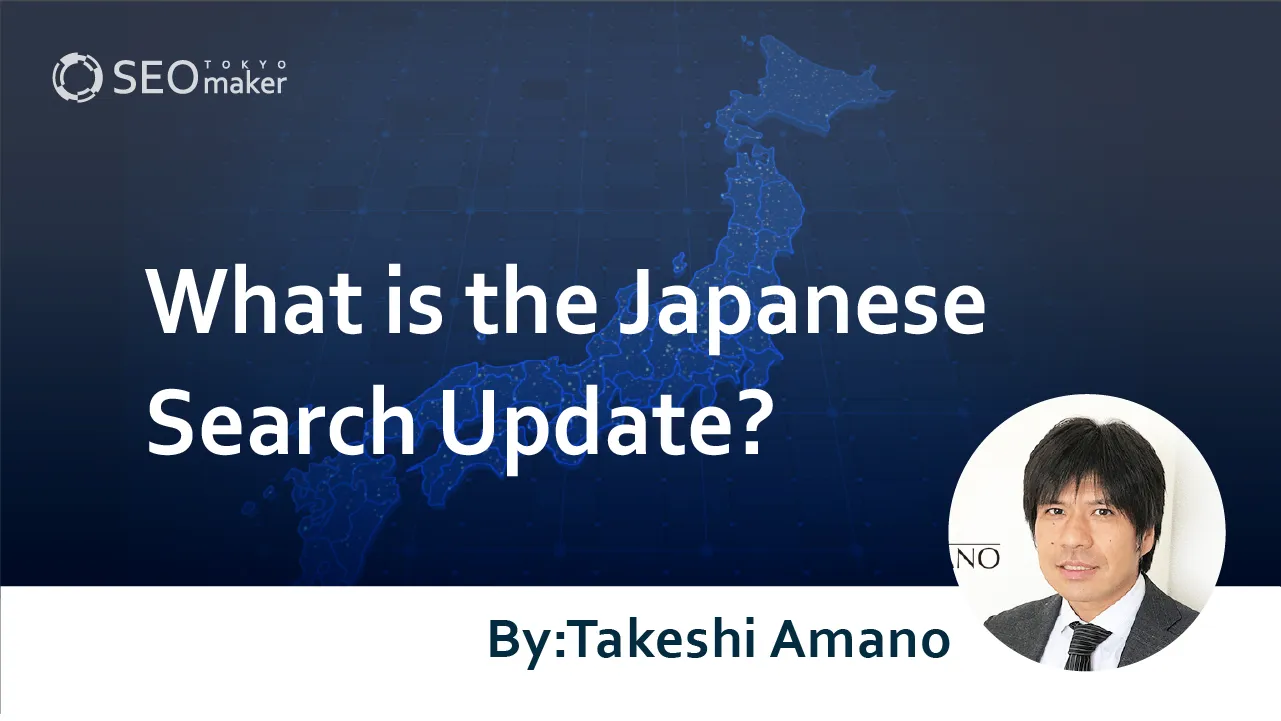What is the Japanese Search Update? ~Key Points and Measures~
contents

This article delves into the SEO and Google search engine updates prompted by the curation media issues in Japan that emerged in 2016.
Google has implemented various measures to prevent recurrence of these issues. For instance, concepts like E-E-A-T and YMYL were introduced as part of these strategies.
Among these updates, the Japanese Search Update became notable, specifically targeting Japanese-language algorithms.
This time, we will explain the Japanese Search Update. Tokyo SEO Maker, an SEO specialist media, has clearly summarized its background and specific countermeasures.
What is Japanese Search Update?
The Japanese Search Update refers to an algorithm update applied to the Japanese Google search engine in February 2017.
This update improved how website quality is assessed. As a result, Japanese websites and pages with thin, low-quality content saw a decline in rankings, enhancing search quality in Japanese search engines.
Background of the Japanese Search Update
- Curation Media Issue Arises
- Google Search Engine Algorithm Update
1.Curation Media Issue Arises
In 2016, a major domestic company faced issues with its curation media for publishing multiple pages containing false information. It was later discovered that this curation media also included copied content.
Related article: What is a Curation Site!? Explaining SEO Tips and Points to Note
This media focused on medical topics and had grown to rank highly in search engine results for medical-related keywords. The discovery of misinformation and copied content in such crucial information concerning human life turned this issue into a societal problem.
2.Google Search Engine Algorithm Update
In response to these issues, Google introduced the following measures.
-Settings for YMYL (Your Money or Your Life)
-Search Engine Algorithm Update
YMYL (Your Money or Your Life) is a concept where content related to crucial life themes such as health and finance is evaluated rigorously. In the YMYL domain, websites are assessed based on four elements: E-E-A-T (Experience, Expertise, Authoritativeness, Trustworthiness).
Related article: What is “Authoritativeness” Emphasized by Google in SEO!? Explaining YMYL and E-E-A-T
Moreover, updates to search engine algorithms were also advanced. In 2017, various algorithm updates were implemented by search engines as measures to prevent the recurrence of such issues.
- Japanese Search Update in February 2017
- Fred Update in March 2017
- Owl Update in April 2017
- Health Update in December 2017
These updates specifically targeted Japanese-language content due to the unique nature of the issues that occurred domestically.
Related article: The History of the Google Search Engine
Affected Content The Japanese Search Update impacts
This update affects the following types of content.
- Japanese-language web pages and sites
- Low quality sites and content
Web Pages and Sites Displaying Japanese
First, the Japanese Search Update targets web pages and sites that display Japanese content. However, not all Japanese-language sites are affected.
Considering the purpose of the update, it is expected that low-quality content, such as false information and copied content, will be significantly impacted. Therefore, web pages or sites that provide value to visitors will not be affected by this update.
Low-Quality Content or Sites
In this update, low-quality pages and sites in Japanese will receive negative evaluations.
This has been clearly stated by Google on Google Search Central.
“This update is aimed at addressing low-quality sites appearing in Japanese searches. We hope these improvements will help create a web ecosystem that fairly evaluates those providing useful and trustworthy content.
Quote: ‘Improving the Quality of Japanese Searches
It seems the purpose of the update is not only to target low-quality sites but also to correctly assess operators who provide high-quality content.
Considering the background leading up to this update, ‘low-quality content’ primarily refers to copied content and misinformation. Thus, the following types of sites were also affected by this update:
- Summary sites where it’s difficult to verify the truth of information
- Review sites composed solely of user posts
- Wiki-type sites where users can freely edit content
Such media have their strengths as platforms for interaction and entertainment. However, they also possess the downside of being laden with misinformation and copied content.
Japanese Search Update Cautions
Google has stated on Google Search Central that this update has not resolved all issues with Japanese searches. Therefore, they will continue to improve the algorithm.
Even if not currently penalized, significant problems could lead to changes in algorithm specifications in the future. It’s important to be aware that new changes could potentially affect your media.
However, as a general rule, as long as you do not employ strategies that exploit SEO loopholes in the Google search engine, major issues are unlikely to arise. Websites that recognize such practices should strive to improve.
Japanese Search Update Measures
This update was conducted with the aim of eliminating low-quality content. Therefore, for most websites, this is an irrelevant algorithm change.
As long as the basic requirements set by Google for search are met, your site is unlikely to be affected by this update.
Reference: Google Search Documents
However, if your site does post misinformation or copied content, the following measures are necessary.
- Train writers
- Have directors supervise articles
- Aim to be a trusted site
Train Writers
Writers with low literacy in web and writing might create and deliver copied content. Such writers may also write articles without verifying the truth of the information.
First, tell writers not to copy and paste from other sites and to discern the veracity of information.
Have Directors Supervise Articles
Suppose an article containing copied content or false information is delivered. Generally, the site operation team’s director checks the manuscript and proceeds with publishing it on the web.
At this time, the director needs the skill to discern if the delivered content is copied or contains false information. Place individuals with high experience and editorial skills as directors for article supervision.
Aim to be a Trusted Site
Given the background of the Japanese Search Update, it makes sense to aim to be a trusted site.
After the curation media issue, Google implemented various measures. For example, concepts like those mentioned were introduced before and after the Japanese Search Update was implemented.
-YMYL
-E-E-A-T
These two concepts are not directly related to the Japanese Search Update, but they are part of the measures introduced to prevent the recurrence of curation media issues, thus playing an indirect role.
In essence, rather than focusing solely on the ‘Japanese Search Update,’ it’s crucial to connect the dots between the ‘Japanese Search Update,’ YMYL, and E-E-A-T to devise the correct strategies.
Related articles: What is YMYL?
Related articles: What is E-E-A-T?
Japanese Search Update FAQs
Here are some frequently asked questions about the Japanese Search Update, presented in an FAQ format.
Q: When was the Japanese Search Update implemented?
A) It was in February 2017.
Q: Why was the update specifically targeted at Japanese?
A) It was to address unique aspects of the Japanese language and culture.
Initially, the curation media problem was uniquely widespread in Japan, exposing significant issues. Thus, the Japanese Search Update was implemented as a special measure.
Q: What is curation media?
A) It refers to web media that compiles information from the web within a specific genre.
Due to its nature, there is a strong tendency for such media to require specialized knowledge. Amidst this, media operated by major domestic companies were scrutinized for failing to fact-check.
Related article: What is a curation site?
Summary
The Japanese Search Update was the first to be implemented specifically for Japanese by the Google search engine. The backdrop of this update includes the curation media issues that came to light in 2016. Consequently, this update is effectively a measure against curation media. Considering the emergence of concepts like E-E-A-T and YMYL, as website operators, it is increasingly important to strive towards being a trusted site.










![What is a Description? Explaining the Meaning, Writing Style, and Changing Word Count – [2023 Edition]](https://www.switchitmaker2.com/en/wp-content/uploads/2024/09/what-is-description.webp)










